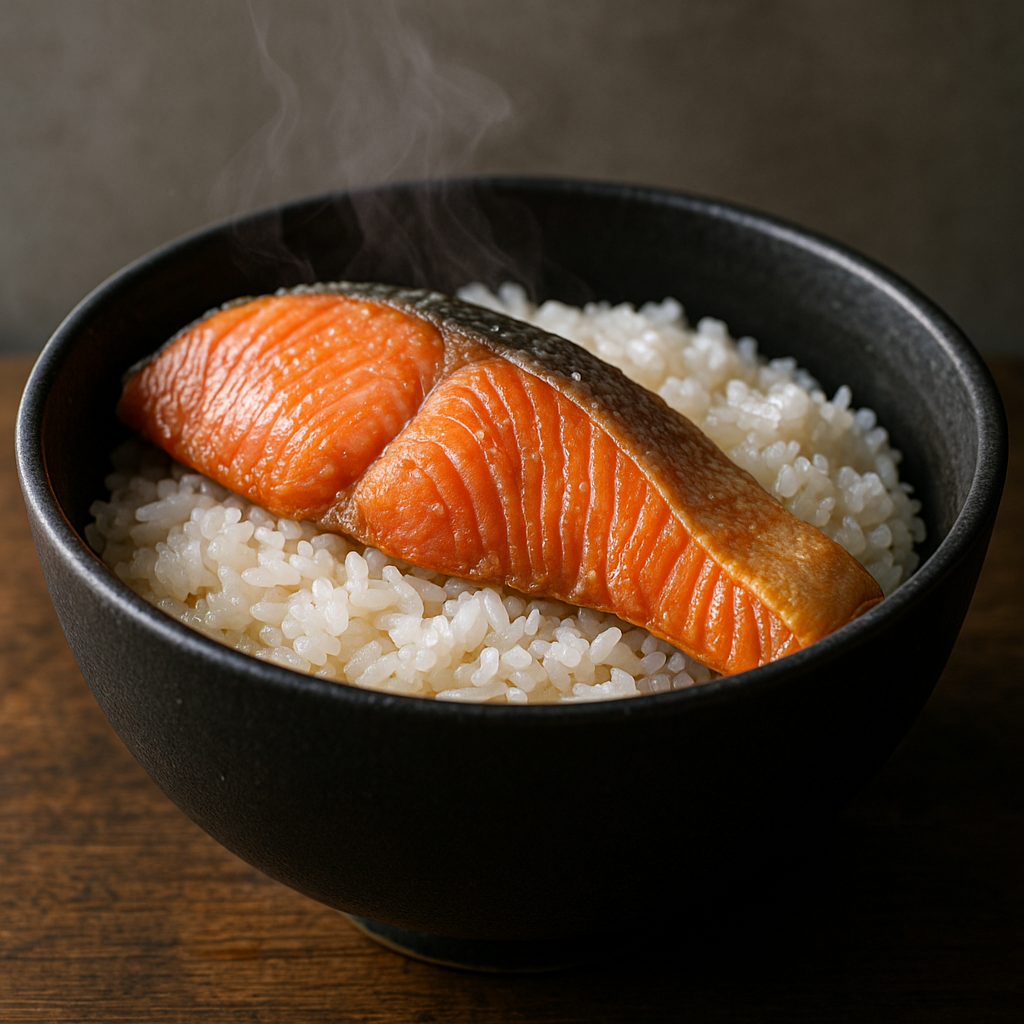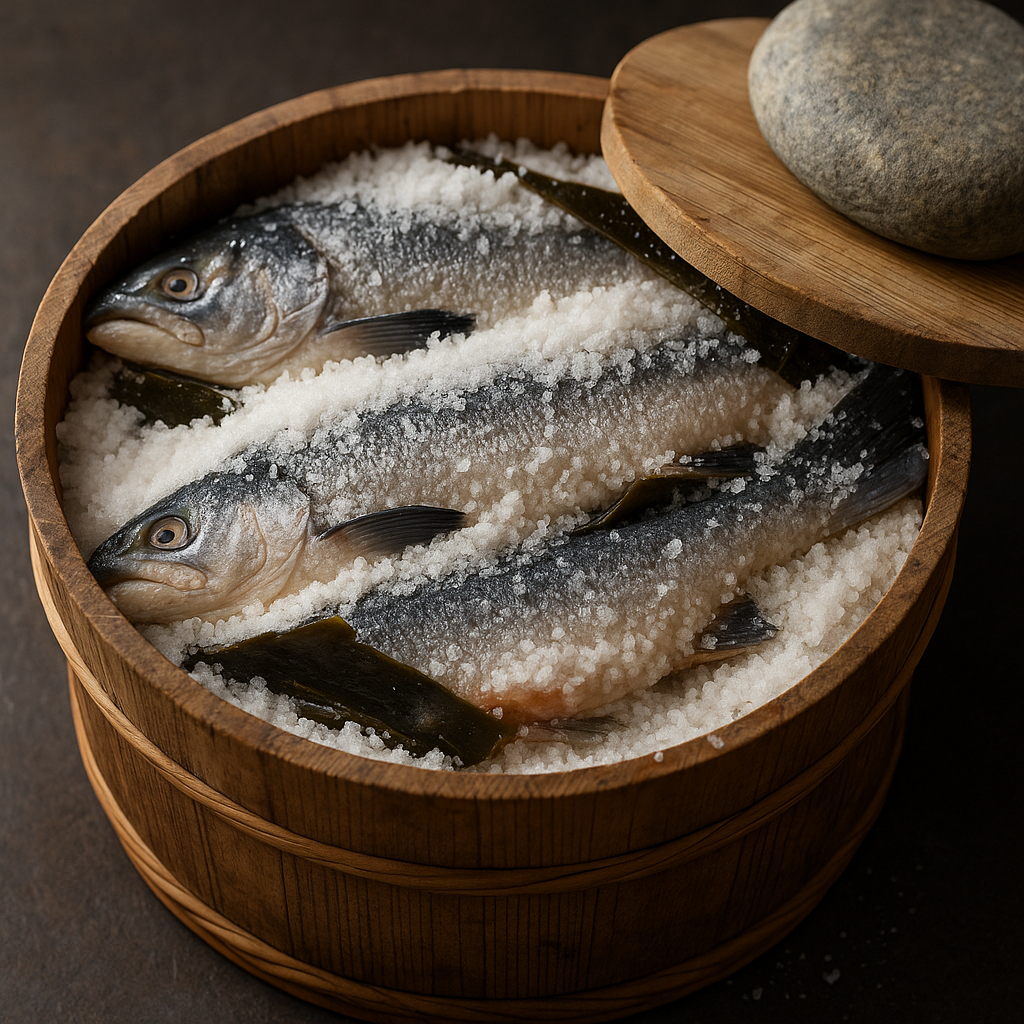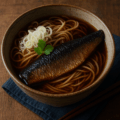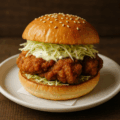
鮭の山漬けの特徴
北海道伝統の保存食
鮭の山漬けは、北海道を代表する伝統的な保存食で、新鮮な鮭にたっぷりの塩をすり込み、山のように積み重ねて漬け込んだものです。独特の熟成によって旨味が増し、保存性も高まります。
熟成による深い味わい
時間をかけて塩漬けにすることで水分が抜け、鮭の身が締まり、独特の深いコクと旨味が引き出されます。焼き物や汁物にしても美味しくいただけます。
祝い事や贈答品としても
保存性と風味の高さから、正月料理や贈答品としても重宝されてきました。北海道の食文化を象徴する一品です。
鮭の山漬けのレシピ(家庭用簡易版)
材料
- 新鮮な鮭 … 1本(または切り身1kg程度)
- 粗塩 … 鮭の重量の10〜15%
作り方
- 鮭を内臓と血合いを丁寧に取り除き、水で洗って水気を拭き取る。
- 全体にたっぷりと塩をすり込み、切り身の場合は身の間にも塩を振る。
- 鮭を樽や保存容器に重ねて入れ、重石をして漬け込む。
- 数日〜1週間ほど冷暗所に置き、水が上がったら取り出して保存する。
シェフのワンポイントアドバイス
伝統的には山のように積み上げて長期熟成させますが、家庭では冷蔵庫で数日漬けるだけでも十分に風味が楽しめます。塩加減は用途に応じて調整してください。
完成したら食べる分だけ切り身にして焼くだけで、手軽なおかずとなります。
鮭の山漬けの栄養価(1人分の目安)
- エネルギー:約200〜250 kcal
- たんぱく質:20〜25 g
- 脂質:8〜12 g(鮭由来の不飽和脂肪酸)
- 炭水化物:0〜1 g
- ビタミンD・B群(鮭由来)
- EPA・DHA(血流改善や脳機能維持に寄与)
- 塩分(漬け込み由来、摂取量に注意)
高たんぱくで良質な脂質を含む一方、塩分が高いため食べ過ぎには注意が必要です。
鮭の山漬けの歴史
保存食としての誕生
鮭の山漬けは、北海道の厳しい冬を乗り越えるための保存食として発展しました。塩蔵により長期間保存が可能となり、貴重なたんぱく源として重宝されました。
交易品としての価値
江戸時代には松前藩を中心に本州へも出荷され、北海道の重要な交易品のひとつとなりました。
現代の山漬け
現在では伝統的な製法を守りながらも、贈答品や郷土料理として提供され、北海道の食文化を代表する存在となっています。
English Version
Features of Yamasuke (Salt-Preserved Salmon)
A Traditional Preserved Food of Hokkaido
Yamasuke is a traditional preserved food from Hokkaido. Fresh salmon is generously rubbed with salt and stacked like a mountain for curing. Through this unique aging process, the umami flavor deepens and the preservation quality improves.
Rich Flavor from Aging
By curing the salmon over time, moisture is drawn out, the flesh firms up, and a distinctive depth of flavor is developed. It can be enjoyed grilled, in soups, or as part of various dishes.
A Dish for Celebrations and Gifts
Because of its excellent shelf life and flavor, Yamasuke has been cherished as a New Year’s dish and also as a valued gift. It remains a symbol of Hokkaido’s food culture.
Recipe (Simple Home Version)
Ingredients
- Fresh salmon … 1 whole fish (or fillets, about 1 kg)
- Coarse salt … 10–15% of the salmon’s weight
Instructions
- Remove the innards and blood from the salmon, wash thoroughly, and pat dry.
- Rub plenty of salt all over the fish. For fillets, sprinkle salt between the cuts as well.
- Place the salmon in a barrel or container, layering it, and press with a weight.
- Leave in a cool, dark place for several days to a week. Once liquid rises to the surface, remove and store.
Chef’s Tip
Traditionally, the salmon is stacked in piles for long-term curing, but at home, even curing for a few days in the refrigerator brings out great flavor. Adjust the salt level depending on how you plan to use it. Once cured, slice only what you need for easy side dishes.
Nutritional Value (per serving, approx.)
- Calories: 200–250 kcal
- Protein: 20–25 g
- Fat: 8–12 g (unsaturated fatty acids from salmon)
- Carbohydrates: 0–1 g
- Vitamins D and B group (from salmon)
- EPA & DHA (support circulation and brain health)
- Sodium (from curing, monitor intake)
High in protein and healthy fats, though the salt content is considerable, so it should be enjoyed in moderation.
Historical Background
Born as a Preserved Food
Yamasuke developed as a way to survive the harsh winters of Hokkaido. Salt-curing allowed salmon to be stored long-term, making it a vital protein source.
A Valuable Trade Item
During the Edo period, it was shipped from Hokkaido, particularly under the Matsumae clan, to Honshu as a valuable trade commodity.
Yamasuke Today
While traditional methods are still practiced, Yamasuke is now also enjoyed as a gift and local specialty, representing Hokkaido’s culinary heritage.



何でも質問してください!